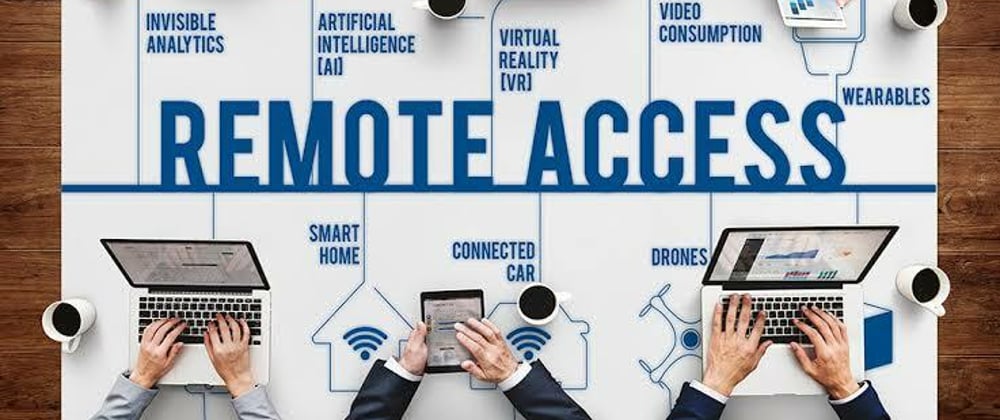Introduction
What is Remote Access?
Remote access refers to the capability for an authorized user to connect to a computer or network over a network from a distance. Users who are physically far away from the systems they need can connect via remote access.
Remote users can at any time access files and other system resources on any computers or servers that are linked to the network thanks to remote access. As a result, employees are more productive and can work more effectively with colleagues around the world.
- VPN
What is a VPN?
The acronym VPN means Virtual Private Network.
A VPN is a service that aids in maintaining your online privacy. A VPN creates a private tunnel for your data and conversations while you utilize public networks, establishing a secure, encrypted connection between your computer and the internet.
VPN as a Remote Access
Through the internet By encrypting all user traffic, a virtual private network (VPN) enables users to safely access and use data and apps that are stored in company data centers and headquarters while working remotely.
A connection to a Virtual Private Network (VPN) is the most common way to provide remote access. Since other users and system administrators can see a user's network traffic on a public network, they often have no expectation of privacy there. Using a VPN, the user and the distant network can communicate privately over a "tunnel." The tunnel safeguards the flow of traffic, preventing its interception or manipulation.
How a VPN Works
No matter what device you use, such as a phone, laptop, or tablet, a VPN works by encrypting your connections. The servers of the VPN service provider receive your data via a secure channel. To the site you're attempting to access, your data is encrypted and redirected.
By building an encrypted tunnel through which your data is routed to a remote server run by your VPN service provider, it enables you to use publicly accessible public Wi-Fi, which is by nature inherently non-private. The data is subsequently sent by the VPN server to the website you want to connect to, encrypted and hidden from hackers and other cybercriminals.
Your computer's performance may occasionally suffer from VPNs. The location of the VPN's servers may cause this to occur. Think about a VPN with global server coverage for the greatest performance. Thus, a closer location can be used to route your data.
The draw backs of a VPN
Speed: It may take longer to access systems over VPNs. A VPN isn't always the ideal choice if access is needed fast or over a slow connection. Access controls are provided by VPNs, but the more restrictions you impose, the less effective the VPN connection becomes. VPN controls slow down the connection process instead of speeding it up, which is expensive for third-party representatives that need a speedy login to address an urgent issue.
Limited Access: Some VPNs restrict access to specific networks that your staff may use. Most VPNs can stop you from attempting to get into your company's systems while you're in fast motion(could be a flight or while driving).
Lacking in credential management: Password protection relies on your third parties protecting your credentials because VPNs can't manage, vault, or obfuscate them. Thus, the obvious question arises: To what extent do you trust your third parties?
No Identification of users: The main drawback of VPNs is the absence of access monitoring. While they are in use, third-party vendors are not recorded or subject to audits by VPNs. They lack the tools necessary to control vendor rep activity or hold reps responsible for their deeds while using a company's network. If there was an incident, there is no way to find its origin, and there is no video to look at to see how it happened.
- RDP
What is an RDP?
The acronym of RDP is Remote Desktop Protocol.
It is a technical standard or protocol that allows users to access desktop computers from a distance.
RDP offers an encrypted tunnel, similar to VPNs, typically using SSL or other techniques, and then permits a "take-over" of an existing user's job, obviating the need for additional credentials. In essence, it enables users to log into another user's computer remotely and behave as if they were physically present on the network.
RDP as a Remote Access
The capability of a different computer to connect to and use a distant desktop computer. As though they were physically seated at their desktop computer, remote desktop users can access their desktop, open and edit files, and utilize applications. In order to access their work computers when away from the office or working from home, employees frequently use remote desktop software.
How an RDP works
Consider a toy car. From a distance, the user controls the drone or automobile by pushing buttons and steering, and their commands are sent to the machine. Similar things happen when someone uses RDP: instead of using radio waves to send their mouse movements and keystrokes to their desktop computer, they do it online. On the computer they are connecting from, the user's desktop is seen just as if they were seated in front of it.
Remote access is provided through RDP over a specific network channel. The data to be communicated is packaged by an RDP-capable program or service, and the Microsoft Communications Service routes the data to an RDP channel. The RDP data is then added to a frame and encrypted by the OS so that it may be transferred.
The draw backs of an RDP
1. Identities of vendors are not managed: It enables anyone with RDP capabilities to access the desktop of another user. Since RDP doesn't require rights, they are unable to track or log user registrations or the permissions granted to each third-party representative.
2. Poor or no access control: There is no method to set up access schedules or notifications. There are workflows for approval, but once a vendor receives clearance, there are no limitations on what they may access inside a network, which unlocks access to the entire organization's network. A vendor representative has the same level of access as the user they are connected to; there is nothing limiting their access.
3. Minimal session surveillance: The majority of monitoring is done based on the employee's whim who grants access to their computer. Furthermore, there is no guarantee that the worker won't leave their computer unattended, allowing a representative (or hacker) access to vital resources and data. The ability to record sessions is available in certain (but not all) desktop sharing software, however this option is rarely turned on.
COMPARISON BETWEEN VPN VS RDP REMOTE ACCESS BASED ON SECURITY
1. RDP and VPN both perform comparable tasks for remote access, however VPNs let users connect to secure networks whereas RDP only provides access to a single machine.
2. The primary distinction between VPN and RDP security is that an RDP, as opposed to a VPN, gives devices more capability. An RDP changes its IP address even when the same device is being utilized in order to increase security.
3. Access controls and session monitoring, two efficient methods of network access security, are absent from VPNs. RDP offers the extra features already described in addition to the unusual case of monitoring.
CONCLUSION
Remote access techniques like VPNs and RDP fall short and are unable to fully safeguard remote access. These antiquated methods, which have been the source of cyberattacks (like Colonial Pipeline), are still insufficient to shield businesses from data breaches.
With VPNs and RDP, the search for secure remote access does not have to end. Use this remote access security checklist to assess the security of your remote connections, or look for third-party access management solutions that outperform VPNs and RDP software.







Top comments (0)